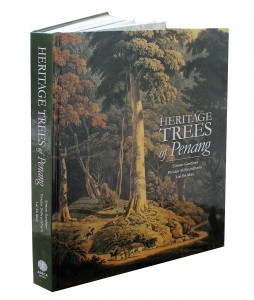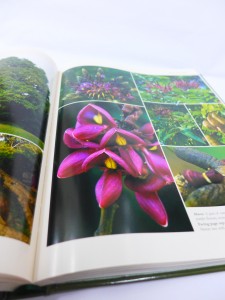Review of ‘Heritage Tree of Penang’ by S.K. Ganesan August 25, 2015 – Posted in: Excerpts, Reviews – Tags: Gardens Bulletin, Heritage Trees of Penang, S.K.Ganesan
 The Gardens’ Bulletin, Singapore
The Gardens’ Bulletin, Singapore
Vol. 64(1 ) 2012 ISSN 0374-7859
Centenary Issue, Singapore Botanic Gardens
pp. 271—272
BOOK REVIEW. Heritage Trees of Penang. Simon Gardner, Pindar Sidisunthorn & Lai Ee May. 2011.
Penang, Malaysia: Areca Books. 27.3cm x 21.7cm, hardcover. 397pp.
ISBN 978-967-5719-06-6. Price RM 100
This is a superb piece of work. The book weaves strands of history, botany, culture and the visual arts into a rich tapestry on the subject of the heritage trees of Penang. The book will appeal to the informed layperson as well to professionals working with plants. The well-thought through layouts of the pages successfully combine stunning photographs and vivid botanical illustrations with just the right amount of text so that almost every page that one flips through is a delight to the eyes. Perhaps an unintended consequence of this is the relatively small font size for the text.
The professional will find that the book is well researched with up-to-date botanical names. The work takes into cognizance relatively recent changes in the family-level taxonomy of the trees treated. A prelude to the scholarship that the reader will find in this book is found in the “Note to Reader” at the opening of the book; here under the heading of “Orthography and Spelling” the authors set out how the Malay names of trees and places are treated in this work in English.
As an entrée before embarking on a sylvan odyssey, the introductory chapter presents convincing arguments on why Penang’s urban and natural forests are an integral part of Penang’s heritage and need to be protected for the future. Particularly noteworthy is a statement on page 4, “Any town or city without trees is simply a collection of buildings and scarcely fit for human habitation”.
Information on the history of tree planting, the Esplanade and the Botanic Gardens in Penang is presented. Trees are then introduced under the broad headings of Sacred trees, Village trees, and Forest trees. These are both informative and interesting. Under “Forest Trees” there is a simplification. In the first paragraph of page 24, the authors write that “… most of the species in Penang belong to the genus Shorea which normally has three-winged fruits”; in fact, Shorea usually has a 5-winged fruit where 3 of the lobes are larger than the other 2.
An interesting brief introduction to the inland forests of Penang is provided. Secondary growth, the vegetation of mangroves, sandy beaches and rocky seashores of the island are similarly treated. The Introductory chapter closes with a useful section on visiting forests in Penang.
About 200 species of trees are treated in the book. These are divided into six sections: Street Trees, Garden Trees, Sacred Trees, Village Trees, Forest Trees, and Coastal and Riverside Trees. The species in each section are arranged in alphabetical order. The format for each species begins with the botanical name followed by vernacular names, general comments, a section on uses, and a section on botany. For the botanical names, the describing authorities have been omitted. The general comments are very useful in highlighting exemplary specimens of the species treated and provide well-researched and interesting information on these individual trees. One of the key features of this book is that the authors have painstakingly provided stunning photographs illustrating the habits, trunks, fruits and flowers of the trees treated. These are augmented by exquisite botanical illustrations usually of the flowers and leaves.
The magnificent trees of the forest dominate with 49 species treated under their section. The photographs and illustrations in the section are among the best in the book. On page 275, together with the flowers of Callerya atropurpurea, a photograph is presented of a pair of perfectly camouflaged caterpillars which are dark purple in colour with a cream stripe, just like the flowers of this tree!
In conclusion, I think that that the book has succeeded through words, photographs and botanical illustrations in drawing attention to these most important assets that Penang has in its heritage trees, urban forests and natural forests.
S.K. Ganesan
Centre for Urban Greenery & Ecology (Research),
National Parks Board
